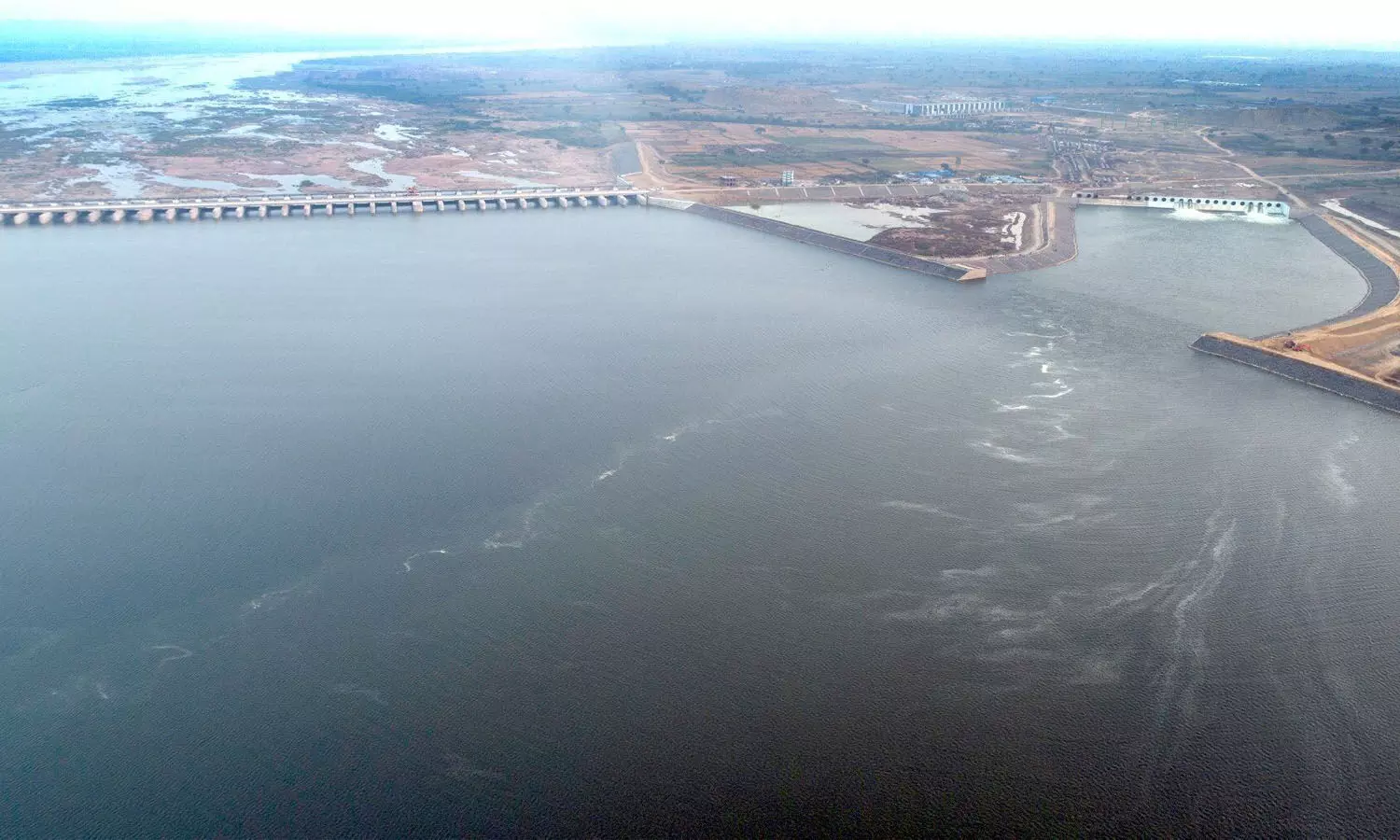NDSA report on Kaleshwaram akin to fabricated reports of ED, CBI on opposition parties
In what could be termed as sheer political conspiracy, the NDSA, on Friday, in its report on the sagging of a pier at the Medigadda Lakshmi Barrage of KLIP suggested that three barrages starting from Lakshmi had to be demolished and reconstructed

HYDERABAD: In what could be termed as sheer political conspiracy, the National Dam Safety Authority (NDSA), on Friday, in its report on the sagging of a pier at the Medigadda Lakshmi Barrage of the Kaleshwaram Lift Irrigation Project (KLIP) suggested that three barrages starting from Lakshmi had to demolished and reconstructed.
In a letter shot to Dr Rajat Kumar, special chief secretary, of the Irrigation and Command Area Development Department, Telangana, the NDSA said that a team of six members visited the Barrage and based on their two-day visit the authority had made certain suggestions.
The NDSA apparently completed the study of the sagging project pier at Medgadda of Mahadevpur mandal in Jayashankar Bhupalapally on a single day (The second day they were at Hyderabad) and submitted its report at breakneck speed giving rise to a suspicion that the report was dictated by the BJP mandarins sitting at the party headquarters in New Delhi.
While the KLIP was considered the ‘lifeline of Telangana’ that changed the agrarian landscape of the drought-prone State, the NDSA working on the lines of the ED and the CBI called the project unstable, suggesting that Annaram and Sundilla Barrages would also meet the same fate and hence marking for reconstruction.
The report reads: “As per the Committee findings, piers had sunk due to a combination of issues involving planning, design, quality control and Operation and maintenance (O&M). As per the Committee, the primary reason for the failure is the settlement of the barrage raft. The piers, being monolith with it, have also settled, moved and cracked. This could occur due to several possible reasons, viz. piping, wherein transportation of foundation material has occurred; inadequate bearing capacity of foundation material [sand); failure of upstream secant piles due to barrage load.”
The report attributed motives to the Telangana Government which had re-engineered the Pranahitha-Chevella project and shifted the inception point from Tummadihatti to Medigadda upon WAPCO a central Government agency and Central Water Commission (CWC) approval.
While all the components of the project including the pumphouses had approvals of central agencies and even the Green Tribunal the NDSA like the ED charge sheets and CBI cases, made an attempt to undermine Telangana’s progress.
Why the issue has been raked up now?
Telangana asked for national status for KLIP, and the Centre did not budge, but how come it was hell-bent on destroying it. When the BJP never saw a political threat, the Centre and its agencies praised the project.
Maharashtra CM and AP CM also came for KLIP’s inauguration as the KLIP was not meant to cause any loss to three states in the riparian areas of Godavari due to the inundation. The CWC chairman after visiting the project in 2018 termed that Kaleshwaram was an engineering marvel. Two days after his visit, Finance Commission Secretary Arvind Mehta lauded Kaleshwaram. The American Society of Civil Engineers (ASCE) gave an award to KLIP after studying the project.
On the other hand, the benefits of the project had been manyfold. While the groundwater level of the parched districts in northern Telangana had come up significantly paddy production jumped from 69 lakh tonnes in 2014 to 3.5 crore tonnes in 2023. In addition to tail-end areas, SRSP was filled through Reverse pumping from KLIP, the project also filled Nizam Sagar and Upper Mannar.
The NDSA team that visited the Lakshmi Barrage argued that the foundation material used didn’t have the bearing capacity. But when did the team take the samples of all three barrages and which lab had reported that the foundtation was sandy and unstable.
It would take at least three days to travel up to Medigadda, Annaram and Sundilla But the team completed their field visit in one day, met Telangana irrigation officials at Hyderabad and left for New Delhi.
In their report, they said that the ‘reconstruction’ of all three barrages was mandatory. But what was the logic in that? When the coffer dam was washed away in Polavaram the NDSA visited the project and hadn’t submitted their report so far. But with Kaleshwaram they completed the field study and the report within a fortnight.
In the history of Indian irrigation, many projects have defects such as the Dhowleswaram, Prakasam Barrage, Pulichintala, Polavaram coffer dam, the Farakka barrage in West Bengal, the Morbi bridge collapse that took 130 lives in Gujarat, the frequent railway accidents despite the presence of ‘Kavach’ shield system.
A State Government’s child
With the BJP-led Centre denying the National Project status to KLIP, the State took it as its own and built the project, and did land acquisition for all the reservoirs on its own, built houses for the oustees. The KLIP created 147 TMC additional storage through SRSP, Nizamsagar, lower, mid and upper Manair, Mallannasagar and Kondapochamma Sagar reservoirs.
The State Government which had entered into agreements with the contractors such as L&T and MEIL so that the maintenance of the project would be undertaken by them at their own cost without spending a rupee from the State exchequer. When the Annaram pumphouse of KLIP was inundated in record Godavari floods, it was revived in just two Months.
A look at the past would tell you that all the projects built by other Governments in erstwhile Andhra Pradesh also faced submergence and structural problems. The past Governments took 64 years to build SRSP, The Srisailam project was built for hydroelectricity and not for drinking and irrigation water for Telangana, and RDS (Rajoli Banda Diversion Scheme) water was built for Rayalaseema. The NDSA must understand why Statehood for Telangana was demanded.
The CWC or the NDSA could also constitute a National or global Neutral party to probe the reason for the sagging of the pillars of the Barrage. The Telangana Irrigation and CAD Department submitted replies to 17 points out of the 20 points raised by the NDSA. But the authority in its letter lied that they received replies for only 11 points, with a rider that other points for which there was no reply meant that the Government never undertook pre and post-monsoon maintenance after the project was built.
On top of the NDSA went to the media even before the State received the report with an evil intention to tarnish the image of the Telangana Government.



